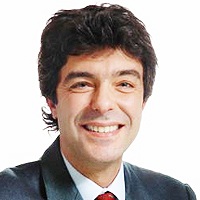Contrast-enhanced Susceptibility Weighted Imaging (CE-SWI) for the Characterization of Musculoskeletal Oncologic Pathology: A Pictorial Essay on the Initial Five-year Experience at a Cancer Institution
Published on: 2nd April, 2024
Susceptibility-weighted imaging (SWI) is based on a 3D high-spatial-resolution, velocity-corrected gradient-echo MRI sequence that uses magnitude and filtered-phase information to create images. It SWI uses tissue magnetic susceptibility differences to generate signal contrast that may arise from paramagnetic (hemosiderin), diamagnetic (minerals and calcifications) and ferromagnetic (metal) molecules. Distinguishing between calcification and blood products is possible through the filtered phase images, helping to visualize osteoblastic and osteolytic bone metastases or demonstrating calcifications and osteoid production in liposarcoma and osteosarcoma. When acquired in combination with the injection of an exogenous contrast agent, contrast-enhanced SWI (CE-SWI) can simultaneously detect the T2* susceptibility effect, T2 signal difference, contrast-induced T1 shortening, and out-of-phase fat and water chemical shift effect. Bone and soft tissue lesion SWI features have been described, including giant cell tumors in bone and synovial sarcomas in soft tissues. We expand on the appearance of benign soft-tissue lesions such as hemangioma, neurofibroma, pigmented villonodular synovitis, abscess, and hematoma. Most myxoid sarcomas demonstrate absent or just low-grade intra-tumoral hemorrhage at the baseline. CE-SWI shows superior differentiation between mature fibrotic T2* dark components and active enhancing T1 shortening components in desmoid fibromatosis. SWI has gained popularity in oncologic MSK imaging because of its sensitivity for displaying hemorrhage in soft tissue lesions, thereby helping to differentiate benign versus malignant soft tissue tumors. The ability to show the viable, enhancing portions of a soft tissue sarcoma separately from hemorrhagic/necrotic components also suggests its utility as a biomarker of tumor treatment response. It is essential to understand and appreciate the differences between spontaneous hemorrhage patterns in high-grade sarcomas and those occurring in the therapy-induced necrosis process in responding tumors. Ring-like hemosiderin SWI pattern is observed in successfully treated sarcomas. CE-SWI also demonstrates early promising results in separating the T2* blooming of healthy iron-loaded bone marrow from the T1-shortened enhancement in bone marrow that is displaced by the tumor.SWI and CE-SWI in MSK oncology learning objectives: SWI and CE-SWI can be used to identify calcifications on MRI.Certain SWI and CE-SWI patterns can correlate with tumor histologic type.CE-SWI can discriminate mature from immature components of desmoid tumors.CE-SWI patterns can help to assess treatment response in soft tissue sarcomas.Understanding CE-SWI patterns in post-surgical changes can also be useful in discriminating between residual and recurrent tumors with overlapping imaging features.
The Healing and Aging-related Properties of Adipose Tissue Fragments Obtained through the Guided SEFFI Procedure’s Mechanical Fragmentation are Facilitated by the Exosomes Present in the Final Injection
Published on: 1st May, 2024
The Injection of autologous Adipose-Derived Stem Cells (ADSCs) and Stromal Vascular Fraction (SVF) into dermal and subdermal layers can improve skin volume and rejuvenation. The SEFFI (Superficial Enhanced Fluid Fat Injection) technique, which involves minimal manipulation of autologous microfragmented adipose tissue, was utilized for harvesting and re-injection, using the SEFFILLER™ disposable medical device. Mechanical fragmentation of adipose tissue is a well-established surgical technique that stimulates tissue regeneration, filler, and biological activity. The study evaluated the biological properties (regenerative and anti-aging) of different harvest and processing fat graft methods among which the fragmented adipose tissue, specifically focusing on the presence of exosomes. Exosomes, nanometer-sized vesicles produced by cells for cellular communication, were found to contain miRNAs with anti-inflammatory, regenerative, and vascular content. The products’ contained exosomes were confirmed in the study through electron microscopy, Western Blotting, gene expression, and sequencing of miRNA content.
Using Isomets as a Foundation, a Connection Factor between Nucleation and Atomic Physics
Published on: 10th June, 2024
The radioactive isomer was initially used to characterize persistent excited atomic states, much like molecular isomers, more than a century ago. Otto Hahn made the first atomic isomer discovery in 1921. Subsequently, it was gradually discovered that there are several kinds of nuclear isomers, such as spin isomer, K isomer, seniority isomer, and “shape and fission” isomer. Isomers are essential to the nucleosynthesis of astrophysical materials. High-accuracy nuclear reaction rate inputs are anticipated while carrying out a celestial nucleosynthesis net computation, even though a single reaction rate can have a significant impact on the whole astronomical evolutionary network. The isotopes are often considered to be in their initial state or to have levels populated in accordance with the thermal-equilibrium distribution of chances when computing nuclear synthesis rates. After all, certain isomers may have lives that reach millions of years or perhaps beyond the age of the cosmos. Thus, in an astrophysics event, such isomers might not be thermally equilibrium. Some atomic isomers—that is, astrometry—should be considered special isotopes since they are crucial to nucleosynthesis. Nuclear batteries can also be produced using nuclear isomers. Similar to the weak force, in certain specific cases such as isomer decays, the electromagnetic force could be crucial for nuclear changes. It is important to note that radioactive isomer states and radioactive ground states are not the same thing. Durable nuclear states of excitement provide insight into the nuclear framework and potential uses. Atomic and molecular changes become interconnected when the connection to the electrons in atoms is made possible by the existence of em decay routes from isomers. Notably renowned chemical decay process is inner conversion. Its inverted, nuclear excitement by free capture of electrons has been observed; however, it is debatable and needs more investigation. This study describes the connection connecting radioactive and molecular changes and discusses instances of manipulating nuclear moves related to isomers using external electromagnetic fields.
Phytochemical Compounds and the Antifungal Activity of Centaurium pulchellum Ethanol Extracts in Iraq
Published on: 25th June, 2024
The current study included a variety of phytochemical substances that were extracted from Centaurium pulchellum and showed a wide range of medicinal properties from the plant's reproductive and vegetative parts against the pathogenic fungus Aspergillus flavus. The vegetative and reproductive components of Centaurium pulchellum were subjected to (GC-MS) analysis for phytochemical study. The data indicated that fungal activity was the highest. Four extract concentrations of 5, 10, 15, and 20 mg/ml were utilized in the investigation, and the diameter of the colonies measured at each concentration was 90.00, 36.00, 28.00, 18.00, and 0.00 mm, respectively.Nine bioactive phytochemical compounds were found in Centaurium pulchellum's vegetative and reproductive portions, according to GC-MS analysis of the chemicals. Another study reported phytochemical substances that: 1-H-Imidazole-2-carboxaldehyde, 1-methyl-;Acetaminophen; n-Hexadecanoic acid; Mercaptoacetic acid, 2TMS derivative; 1.2,3-Dimethyl-5-(trifluoromethyl)-1,4-benzenediol #; Mercaptoethanol, 2TMS derivative-; Bis-(3,5,5-trimethylhexyl) phthalate Tetrakis(trimethylsilyl) orthosilicate #;- 1.1-Isopropoxy-3,3,3-trimethyl-1-[(trimethylsilyl)oxy]disiloxanyl tris(trimethylsilyl) orthosilicate #.
Seminal Extracellular Traps in SARS-CoV-2 Infection
Published on: 19th August, 2024
Introduction: Extracellular Traps (ETs) are fibers composed of chromatin and cytoplasmic proteins, which can trap and kill pathogens by the phenomenon called ETosis. They are released by neutrophils, macrophages, and monocytes, and can be found in semen. The aim of this presentation is to evidence of the indirect effect of SARS-CoV-2 in semen by ETs.Patients and methods: Experimental design: retrospective descriptive observational study.Semen samples from two groups were studied following WHO guidelines: 1) SARS-CoV-2 infected donors (n: 5; at 7, 15, 30, 60, and 90 days after PCR diagnosis); 2) COVID-19 positive patients assisted in our laboratory between 2021 and 2022 (n: 70). They were observed in fresh and in Papanicolaou-stained smears by CASA and light microscopy; the presence of macrophages, spermiophages, ETs and hyperviscosity were recorded while neutrophilic concentration was calculated. Two control groups were designed: a) Patients belonging to group 2, studied before de pandemia (n: 13); b) Culture-negative semen samples (n: 28).Results: In the first group, ETs were observed in all the samples, while only 18% had leucospermia. Macrophages, spermiophages, and hyperviscosity were recorded in 68%, 27%, and 36% of the studied cases respectively.In the second group, ETs were present 100% in the acute phase (< 90 days after diagnosis) and decreased to 71% in the later stage (90 to 270 days). The trapped sperm were non-progressive motile or immotile alive or dead.No traps were found in either control group.Conclusion: In our study ETs were the most sensitive seminal marker of SARS-CoV-2 infection.
Simulation and Analysis of Photonic Bandgapsin 1D Photonic Crystals Using MEEP
Published on: 23rd August, 2024
This study presents a comprehensive simulation and analysis of photonic band gaps in one-dimensional (1D) photonic crystals using the open-source software MEEP. Photonic crystals, with their periodic structures, exhibit photonic bandgaps that prevent the propagation of specific wavelengths of light, making them crucial for various optical applications. Unlike previous studies that primarily focused on theoretical and experimental methods, this research introduces a novel computational approach that enhances the accuracy and flexibility of modeling these bandgaps. Through detailed simulations, we explore the impact of different structural parameters on the photonic bandgap properties, providing valuable insights into optimizing these crystals for practical use. Our findings demonstrate significant improvements in the design and understanding of 1D photonic crystals, particularly in tailoring bandgaps for specific applications in optical devices. This work contributes to the advancement of photonic crystal technology by offering a robust framework for their analysis and application.
A Comparative Analysis of Traditional Latent Fingerprint Visualization Methods and Innovative Silica Gel G Powder Approach
Published on: 19th September, 2024
Latent fingerprints are a common source of information for forensic experts and law enforcement agencies. The thin layer chromatography (TLC) plates that are prepared in this work are made with silica gel G powder. Latent fingerprint remnants are made up of secretions from the nose, palm, and sebaceous, apocrine, and eccrine glands (sweat). However, the quest for more versatile and effective techniques persisted, leading to the emergence of innovative approaches like Silica Gel G powder. The silicon atoms are linked to –OH groups at the silica gel’s surface. A latent fingerprint is an imprint left by direct contact with a surface or object that is not apparent to the unaided eye. The advantages of using Silica Gel G powder for latent fingerprint visualization underscore its significance as an innovative technique in forensic science. The latent fingerprints were developed on each of the several substrates using Merck Specialties Private Limited’s white-coloured silica gel G powder. There are several techniques in the literature for creating latent fingerprints. The emergence of Silica Gel G powder in forensic science represents a significant breakthrough in the visualization of latent fingerprints. The process of using Silica Gel G powder for latent fingerprint visualization exemplifies the precision and attention to detail required in forensic investigations.
Fibrothecal Tumors of the Ovary - Case Report
Published on: 11th November, 2024
Fibrothecal tumors of the ovary are rare neoplasms, comprising less than 4% of all ovarian tumors and primarily affecting post-menopausal women. These benign tumors arise from the stromal tissue of the ovary and may produce hormones, particularly estrogen. Their diagnosis presents considerable challenges, frequently leading to misclassification as malignant ovarian tumors or uterine myomas. This report describes the case of a 59-year-old woman who presented with abdominal distension and pelvic pain. Clinical examination revealed a large, lobulated mass and imaging studies classified the right ovarian mass as ORADS 4. An exploratory laparotomy confirmed the absence of metastasis, resulting in total hysterectomy, bilateral adnexectomy, and omentectomy. The anatomopathological analysis identified the latero-ovarian mass as a fibrothecoma. Generally, fibrothecal tumors are benign with a favorable prognosis following surgical intervention. Common symptoms include pelvic pain and abdominal distension, and diagnosis typically relies on imaging techniques such as ultrasound and CT, with definitive confirmation achieved through histopathological examination. Given their potential to mimic malignant ovarian cancer, accurate diagnosis is critical and necessitates a multidisciplinary approach.
Antimicrobial, Antioxidant Activity of Ethyl Acetate Extract of Streptomyces sp. PERM2, its Potential Modes of Action and Bioactive Compounds
Published on: 18th November, 2024
Background: Microorganisms belonging to Streptomyces sp. are Gram-positive bacteria known for their unsurpassed capacity for the production of secondary metabolites with diverse biological activities. The aim of this study was to evaluate the antimicrobial and antioxidant properties of ethyl acetate Streptomyces sp. PERM2 extract, its potential modes of action and bioactive secondary metabolites.Results: The ethyl acetate PERM2 extract showed antimicrobial activity more pronounced on both Gram-positive and Gram-negative bacteria and fungi with a Minimum Inhibitory Concentration value (MIC) of 0.5 mg/mL and Minimum Bactericidal Concentration (MBC) of 2 - 4 mg/mL against bacterial pathogens. MIC value against pathogenic fungi was 2 mg/mL and Minimum Fungicidal Concentration (MFC) of 0.01 - 0.05 mg/mL against pathogenic fungi. PERM2 crude extract showed the ability to inhibit bacteria cell wall synthesis at 0.5 and 1 MIC. The extract was found to possess dose-dependent 2,2-Diphenyl-picrylhadrazyl (DPPH) free radical scavenging and Ferric reducing activity. The gas chromatography-mass spectrometry (GC-MS) analysis revealed the presence of three major compounds identified as 9,12-octadecadienoic acid (Z, Z) (29.75%), tridecyl trifluoroacetate (24.82%) and 1-(+)-ascorbic acid 2, 6-dihexadecanoate (22.34%). The liquid chromatography-tandem mass spectrometry (LC-MS/MS) analysis revealed the presence of 22 non-volatile metabolites in PERM2 extract and only the compound 3, 30-O-dimethylellagic acid was identified. Conclusion: The results of this study indicate that ethyl acetate Streptomyces sp. PERM2 extract possesses antibacterial, antifungal, and antioxidant activities; inhibits bacteria cell wall and protein synthesis; and contains significant bioactive secondary metabolites which could be used as an alternative to multi-resistance antibiotics.
The Theory of Elements
Published on: 7th January, 2025
The spin of a physical object is a vector which is held by the self-rotation axis of the object. Spin measures the intensity of the self-rotation of the object around its axis. The sudden and forceful, but direct contact of two bodies is known as collision. The collision is supposed to be perfectly elastic. Newton stated the law of universal attraction. The formula of Biot & Savart is unavoidable if we are interested by electromagnetism; this formula led to the famous equations of Maxwell. Curiously, this formula includes a vector product which may seem quite unusual. An electric current, which flows in an electric wire, creates, by induction, another current of small particles, all around the wire. The colors are intensities of reflections, due to the self-rotation of atoms of the colored objects. The stars novas are due to sudden appearance of storms of space winds, which strike the stars, and which make them self-rotate faster and then it became brighter.
Efficient Sequential Chromatographic Purification of a Recombinant Nanobody-Fc Fusion Designed for Treatment of Severe Fever with Thrombocytopenia Syndrome
Published on: 29th January, 2025
Severe fever with thrombocytopenia syndrome (SFTS) is caused by a virus that induces acute infections. Despite its expansion beyond China, where it first appeared in 2009, no specific drug exists to treat the disease. The discovery that antibodies targeting the SFTS virus surface glycoprotein (Glycoprotein N, GN) significantly enhance patient survival has driven the development of antibodies, particularly nanobodies. Nanobodies targeting the GN protein are a promising therapeutic approach. This paper presents a systematic study of the purification process for a recombinant nanobody-Fc fusion designed to treat the SFTS virus HB29. The study evaluated a sequential purification approach using affinity (AFF), ion exchange (IEC), and hydrophobic interaction chromatography (HIC) techniques to gradually remove impurities. The results demonstrate that this approach achieves an overall yield of more than 50% and a total purity of 95%. Efficient nanobody purification methods, as outlined here, can pave the way for novel treatments to manage this disease.
Clinical and Histopathological Mismatch: A Case Report of Acral Fibromyxoma
Published on: 7th April, 2025
Background: Acral Fibromyxoma (AFM) is a rare benign soft tissue tumour which is described as a fibromatous and myxoid tumour of skin and soft tissue. Case details: A 40-year-old male presented to the Dermatology outpatient department with swelling over the wrist of one year duration. The swelling was associated with mild pain, and it gradually increased in size to reach its present size. Cutaneous examination revealed a 2x2 cm mobile, cystic to firm, non-tender swelling over the dorsum of the right wrist. Based on its location and clinical features, it was provisionally diagnosed as a ganglion cyst and excision biopsy was done. Histology showed stellate-shaped cells in a myxoid background with round to oval nuclei having a small, inconspicuous nucleolus. Acral fibromyxoma presents a distinct histopathology including a myxoid stroma and spindle-shaped cells, which are essential for accurate diagnosis and management.
















